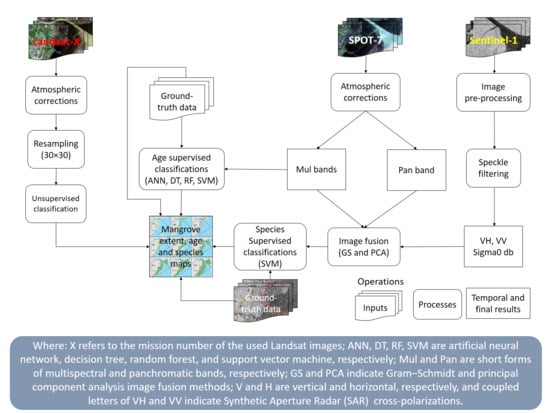Multi-Decadal Changes in Mangrove Extent, Age and Species in the Red River Estuaries of Viet Nam
Abstract
1. Introductions
2. Materials and Methods
2.1. Study Site
2.2. Data Collection
2.2.1. Ground-Truth Data Collection
2.2.2. Remote Sensing Data
2.3. Methodology
2.3.1. Mangrove Age Classification
2.3.2. Image Fusion
2.3.3. Mangrove Species Categorization
2.3.4. Mangrove Extent Classification
2.3.5. Evaluation
2.3.6. Mangrove Mapping
3. Results
3.1. Mangrove Age Classifications
3.2. Image Fusion
3.3. Mangrove Species Maps
3.4. Mangrove Extent Changes
3.5. Accuracy Assessment
3.5.1. Mangrove Age Classification
3.5.2. Mangrove Species Classification
3.5.3. Mangrove Extent Classification
4. Discussion
5. Conclusions
Author Contributions
Funding
Acknowledgments
Conflicts of Interest
Abbreviations
| No | Abbreviation | Full Name |
| 1 | ANN | Artificial Neural Network |
| 2 | DT | Decision Tree |
| 3 | GPS | Global Positioning System |
| 4 | GS | Gram–Schmidt |
| 5 | H | Horizontal |
| 6 | IHS | Intensity-Hue-Saturation |
| 7 | ISODATA | Iterative Self-organizing Data Analysis Technique |
| 8 | LULC | Land Use and Land Cover |
| 9 | MS | Multispectral |
| 10 | NIR | Near Infrared |
| 11 | PAN | Panchromatic |
| 12 | PCA | Principal Component Analysis |
| 13 | RF | Random Forest |
| 14 | RRD | Red River Delta |
| 15 | SAR | Synthetic Aperture Radar |
| 16 | SVM | Support Vector Machine |
| 17 | USGS | United States Geological Survey |
| 18 | V | Vertical |
References
- Cummings, C.A.; Todhunter, P.E.; Rundquist, B.C. Using the Hazus-MH flood model to evaluate community relocation as a flood mitigation response to terminal lake flooding: The case of Minnewaukan, North Dakota, USA. Appl. Geogr. 2012, 32, 889–895. [Google Scholar] [CrossRef]
- Heenkenda, M.K.; Joyce, K.E.; Maier, S.W.; de Bruin, S. Quantifying mangrove chlorophyll from high spatial resolution imagery. ISPRS J. Photogramm. Remote Sens. 2015, 108, 234–244. [Google Scholar] [CrossRef]
- VEA, The Vietnam environment administration. In Ministry of Natural Resources and Environment; 2016. Available online: http://vea.gov.vn/vn/truyenthong/biendoikhihau/Pages/90KH.aspx (accessed on 28 October 2019).
- Hoa, N.H. Using Landsat imagery and vegetation indices differencing to detect mangrove change: A case in Thai Thuy District, Thai Binh Province. J. For. Sci. Technol. 2016, 5, 59–66. [Google Scholar]
- Bakhtiyari, M.; Lee, S.Y.; Warnken, J. Seeing the forest as well as the trees: An expert opinion approach to identifying holistic condition indicators for mangrove ecosystems. Estuar. Coast. Shelf Sci. 2019, 222, 183–194. [Google Scholar] [CrossRef]
- Hasmadi, M.; Pakhriazad, H.; Shahrin, M. Evaluating supervised and unsupervised techniques for land cover mapping using remote sensing data. Geogr. Malays. J. Soc. Space 2009, 5, 1–10. [Google Scholar]
- Hepner, G.; Logan, T.; Ritter, N.; Bryant, N. Artificial neural network classification using a minimal training set- Comparison to conventional supervised classification. Photogramm. Eng. Rem. Sci. 1990, 56, 469–473. [Google Scholar]
- Sohn, Y.; Rebello, N.S. Supervised and unsupervised spectral angle classifiers. Photogramm. Eng. Rem. Sci. 2002, 68, 1271–1282. [Google Scholar]
- Amarsaikhan, D.; Douglas, T. Data fusion and multisource image classification. Int. J. Remote Sens. 2004, 25, 3529–3539. [Google Scholar] [CrossRef]
- Belgiu, M.; Stein, A. Spatiotemporal Image Fusion in Remote Sensing. Remote Sens. 2019, 11, 818. [Google Scholar] [CrossRef]
- Mangolini, M. Apport de la fusion d’images satellitaires multicapteurs au niveau pixel en télédétection et photo-interprétation. Ph.D. Thesis, Université de Nice Sophia-Antipolis, Nice, France, 1994. [Google Scholar]
- Ehlers, M. Spectral characteristics preserving image fusion based on Fourier domain filtering. in Remote Sensing for Environmental Monitoring, GIS Applications, and Geology IV. In Proceedings of the International Society for Optics and Photonics (SPIE), SPIE Bellingham, WA, USA, 22 October 2004. [Google Scholar]
- Rokni, K.; Ahmad, A.; Solaimani, K.; Hazini, S. A new approach for surface water change detection: Integration of pixel level image fusion and image classification techniques. Int. J. Appl. Earth Obs. 2015, 34, 226–234. [Google Scholar] [CrossRef]
- Pohl, C.; van Genderen, J.L. Review article multisensor image fusion in remote sensing: Concepts, methods and applications. Int. J. Remote Sens. 1998, 19, 823–854. [Google Scholar] [CrossRef]
- Quang, N.H.; Tuan, V.A.; Hao, N.T.P.; Hang, L.T.T.; Hung, N.M.; Anh, V.L.; Phuong, L.T.M.; Carrie, R. Synthetic aperture radar and optical remote sensing image fusion for flood monitoring in the Vietnam lower Mekong basin: A prototype application for the Vietnam Open Data Cube. Eur. J. Remote Sens. 2019, 52, 599–612. [Google Scholar]
- Solberg, A.H.S.; Jain, A.K.; Taxt, T. Multisource classification of remotely sensed data: Fusion of Landsat TM and SAR images. IEEE Trans. Geosci. Remote 1994, 32, 768–778. [Google Scholar] [CrossRef]
- Wang, L.; Jia, M.; Yin, D.; Tian, J. A review of remote sensing for mangrove forests: 1956–2018. Remote Sens. Environ. 2019, 231, 111223. [Google Scholar] [CrossRef]
- Pham, T.D.; Le, N.N.; Ha, N.T.; Nguyen, L.V.; Xia, J.; Yokoya, N.; To, T.T.; Trinh, H.X.; Kieu, L.Q.; Takeuchi, W. Estimating Mangrove Above-Ground Biomass Using Extreme Gradient Boosting Decision Trees Algorithm with Fused Sentinel-2 and ALOS-2 PALSAR-2 Data in Can Gio Biosphere Reserve, Vietnam. Remote Sens. 2020, 12, 777. [Google Scholar] [CrossRef]
- Proisy, C.; Couteron, P.; Fromard, F. Predicting and mapping mangrove biomass from canopy grain analysis using Fourier-based textural ordination of IKONOS images. Remote Sens. Environ. 2007, 109, 379–392. [Google Scholar] [CrossRef]
- Wicaksono, P.; Danoedoro, P.; Hartono; Nehren, U. Mangrove biomass carbon stock mapping of the Karimunjawa Islands using multispectral remote sensing. Int. J. Remote Sens. 2016, 37, 26–52. [Google Scholar] [CrossRef]
- Aslan, A.; Rahman, A.F.; Warren, M.W.; Robeson, S.M. Mapping spatial distribution and biomass of coastal wetland vegetation in Indonesian Papua by combining active and passive remotely sensed data. Remote Sens. Environ. 2016, 183, 65–81. [Google Scholar] [CrossRef]
- Vidhya, R.; Vijayasekaran, D.; Farook, M.A.; Jai, S.; Rohini, M.; Sinduja, A.; Vi, C.; Vi, W.G. Improved classification of mangroves health status using hyperspectral remote sensing data. Int. Arch. Photogramm. Remote Sens. Spat. Inf. Sci. 2014, 40, 667. [Google Scholar] [CrossRef]
- Chellamani, P.; Singh, C.P.; Panigrahy, S. Assessment of the health status of Indian mangrove ecosystems using multi temporal remote sensing data. Trop. Ecol. 2014, 55, 245–253. [Google Scholar]
- Hernández-Clemente, R.; North, P.R.; Hornero, A.; Zarco-Tejada, P.J. Assessing the effects of forest health on sun-induced chlorophyll fluorescence using the FluorFLIGHT 3-D radiative transfer model to account for forest structure. Remote Sens. Environ. 2017, 193, 165–179. [Google Scholar] [CrossRef]
- Mohammed, G.H.; Colombo, R.; Middleton, E.M.; Rascher, U.; van der Tol, C.; Nedbal, L.; Goulas, Y.; Pérez-Priego, O.; Damm, A.; Meroni, M.; et al. Remote sensing of solar-induced chlorophyll fluorescence (SIF) in vegetation: 50 years of progress. Remote Sens. Environ. 2019, 231, 111177. [Google Scholar] [CrossRef]
- Pastor-Guzman, J.; Atkinson, P.M.; Dash, J.; Rioja-Nieto, R. Spatiotemporal variation in mangrove chlorophyll concentration using Landsat 8. Remote Sens. 2015, 7, 14530–14558. [Google Scholar] [CrossRef]
- Vaiphasa, C. Remote sensing techniques for mangrove mapping. Ph.D. Thesis, International Institute for Geo-information Science and Earth Observation (ITC), Enschede and Wageningen University, Enschede, The Netherlands, 2006. [Google Scholar]
- Green, E.P.; Clark, C.D.; Mumby, P.J.; Edwards, A.J.; Ellis, A.C. Remote sensing techniques for mangrove mapping. Int. J. Remote Sens. 1998, 19, 935–956. [Google Scholar] [CrossRef]
- Blasco, F.; Gauquelin, T.; Rasolofoharinoro, M.; Denis, J.; Aizpuru, M.; Caldairou, V. Recent advances in mangrove studies using remote sensing data. Mar. Freshwater Res. 1998, 49, 287–296. [Google Scholar] [CrossRef]
- Hoan, N.T.; Duong, N.D.; Tateishi, R. Combination of ADEOS II–GLI and MODIS 250m Data for Land Cover Mapping of Indochina Peninsula. In Proceedings of the 26th Asian Conference on Remote Sensing and 2nd Asian Space Conference, Hanoi, Vietnam, 7–11 November 2005. [Google Scholar]
- Lymburner, L.; Bunting, P.; Lucas, R.; Scarth, P.; Alam, I.; Phillips, C.; Ticehurst, C.; Held, A. Mapping the multi-decadal mangrove dynamics of the Australian coastline. Remote Sens. Environ. 2020, 238, 111185. [Google Scholar] [CrossRef]
- Long, J.B.; Giri, C. Mapping the Philippines’ mangrove forests using Landsat imagery. Sensors 2011, 11, 2972–2981. [Google Scholar] [CrossRef]
- Tong, P.H.S.; Auda, Y.; Populus, J.; Aizpuru, M.; Habshi, A.A.; Blasco, F. Assessment from space of mangroves evolution in the Mekong Delta, in relation to extensive shrimp farming. Int. J. Remote Sens. 2004, 25, 4795–4812. [Google Scholar] [CrossRef]
- Tri, N.H.; Adger, W.; Kelly, P. Natural resource management in mitigating climate impacts: The example of mangrove restoration in Vietnam. Glob. Environ. Chang. 1998, 8, 49–61. [Google Scholar]
- Tri, N.H.; Adger, W.N.; Kelly, P.M. Social vulnerability to climate change and extremes in coastal Vietnam. World Dev. 1999, 27, 249–269. [Google Scholar]
- Pham, Q.T. An analysis of soil characteristics for agricultural land use orientation in Thai Thuy District, Thai Binh Province. VNU J. Sci. Earth Sci. 2007, 23, 105–109. [Google Scholar]
- Powell, N.; Osbeck, M.; Tan, S.B.; Toan, V.C. Mangrove restoration and rehabilitation for climate change adaptation in Vietnam. World Resources Report, Washington DC. World Resour. Rep. 2011, 1–22. [Google Scholar]
- Macintosh, D.J.; Ashton, E.C. A Review of Mangrove Biodiversity Conservation and Management; Centre for Tropical Ecosystems Research: Aarhus, Denmark, 2002. [Google Scholar]
- Giang, H.; Manh, D.; Huy, N. Use of Salt-Marsh Site Classification for Mangrove Forest Development and Reforestation in the Coastal Area of Thai Binh Province in the Context of Climate Change. In International Conference on Asian and Pacific Coasts; Springer: Berlin/Heidelberg, Germany, 2019. [Google Scholar]
- Ouaidrari, H.; Vermote, E.F. Operational atmospheric correction of Landsat TM data. Remote Sens. Environ. 1999, 70, 4–15. [Google Scholar] [CrossRef]
- Lu, D.; Mausel, P.; Brondizio, E.; Moran, E. Assessment of atmospheric correction methods for Landsat TM data applicable to Amazon basin LBA research. Int. J. Remote Sens. 2002, 23, 2651–2671. [Google Scholar] [CrossRef]
- Rahman, M.R.; Thakur, P.K. Detecting, mapping and analysing of flood water propagation using synthetic aperture radar (SAR) satellite data and GIS: A case study from the Kendrapara District of Orissa State of India. Egypt. J. Remote Sens. Space Sci. 2017, 21, S37–S41. [Google Scholar] [CrossRef]
- Cian, F.; Marconcini, M.; Ceccato, P. Normalized Difference Flood Index for rapid flood mapping: Taking advantage of EO big data. Remote Sens. Environ. 2018, 209, 712–730. [Google Scholar] [CrossRef]
- Nazim, K.; Ahmed, M.; Shaukat, S.S.; Khan, M.U.; Ali, Q.M. Age and growth rate estimation of grey mangrove Avicennia marina (Forsk). Vierh Pakistan. Pak. J. Bot. 2013, 45, 535–542. [Google Scholar]
- Duarte, C.M.; Thampanya, U.; Terrados, J.; Geertz-Hansen, O.; Fortes, M.D. The determination of the age and growth of SE Asian mangrove seedlings from internodal counts. Mangroves Salt Marshes. 1999, 3, 251–257. [Google Scholar] [CrossRef]
- Maxwell, A.E.; Warner, T.A.; Fang, F. Implementation of machine-learning classification in remote sensing: An applied review. Int. J. Remote Sens. 2018, 39, 2784–2817. [Google Scholar] [CrossRef]
- Yu, L.; Liang, L.; Wang, J.; Zhao, Y.; Cheng, Q.; Hu, L.; Liu, S.; Yu, L.; Wang, X.; Zhu, P.; et al. Meta-discoveries from a synthesis of satellite-based land-cover mapping research. Int. J. Remote Sens. 2014, 35, 4573–4588. [Google Scholar] [CrossRef]
- Foody, G.M. Relating the land-cover composition of mixed pixels to artificial neural network classification output. Photogramm. Eng. Rem. Sci. 1996, 62, 491–498. [Google Scholar]
- Dreiseitl, S.; Ohno-Machado, L. Logistic regression and artificial neural network classification models: A methodology review. J. Biomed. Inform. 2002, 35, 352–359. [Google Scholar] [CrossRef]
- Schalkoff, R. Pattern Recognition: Statistical, Structural and Neural Approaches; John Wiley: Toronto, ON, Canada, 1992. [Google Scholar]
- Pal, M.; Mather, P.M. An assessment of the effectiveness of decision tree methods for land cover classification. Remote Sens. Environ. 2003, 86, 554–565. [Google Scholar] [CrossRef]
- Brodley, C.E.; Utgoff, P.E. Multivariate Versus Univariate Decision Trees; Department of Computer and Information Science, University of Massachusetts: Amherst, MA, USA, 1992. [Google Scholar]
- Breiman, L. Random forests. Mach. Learn. 2001, 45, 5–32. [Google Scholar] [CrossRef]
- Noi, P.T.; Degener, J.; Kappas, M. Comparison of multiple linear regression, cubist regression, and random forest algorithms to estimate daily air surface temperature from dynamic combinations of MODIS LST data. Remote Sens. 2017, 9, 398. [Google Scholar] [CrossRef]
- Breiman, L. Bagging predictors. Mach. Learn. 1996, 24, 123–140. [Google Scholar] [CrossRef]
- Quinlan, J.R. C4. 5: Programs for Machine Learning; Elsevier: Amsterdam, The Netherlands, 2014. [Google Scholar]
- Ben-Hur, A.; Horn, D.; Siegelmann, H.T.; Vapnik, V. Support vector clustering. J. Mach. Learn. Res. 2001, 2, 125–137. [Google Scholar] [CrossRef]
- Vapnik, V.N. The Nature of Statistical Learning Theory; Springer: New York, NY, USA, 1995. [Google Scholar]
- Wu, T.F.; Lin, C.J.; Weng, R.C. Probability estimates for multi-class classification by pairwise coupling. J. Mach. Learn. Res. 2004, 5, 975–1005. [Google Scholar]
- Hsu, C.W.; Chang, C.C.; Lin, C.J. A Practical Guide to Support Vector Classification; National Taiwan University: Taipei, Taiwan, 2003; pp. 1396–1400. [Google Scholar]
- Laben, C.A.; Brower, B.V. Process for Enhancing the Spatial Resolution of Multispectral Imagery Using Pan-sharpening. U.S. Patent No. 6,011,875, 4 January 2000. [Google Scholar]
- Abdi, H.; Williams, L.J. Principal component analysis. Wiley Interdiscip. Rev. Comput. Stat. 2010, 4, 433–459. [Google Scholar] [CrossRef]
- Aiazzi, B.; Alparone, L.; Baronti, S.; Selva, M. MS+ Pan image fusion by an enhanced Gram–Schmidt spectral sharpening. In Proceedings of the 26th EARSeL symposium, Warsaw, Poland, 29 May–1 June 2006; Millpress: Rotterdam, The Netherlands, 2007. [Google Scholar]
- Kumar, U.; Mukhopadhyay, C.; Ramachandra, T. Pixel based fusion using IKONOS imagery. Int. J. Recent Trends Eng. 2009, 1, 173. [Google Scholar]
- Kamal, M.; Phinn, S. Hyperspectral data for mangrove species mapping: A comparison of pixel-based and object-based approach. Remote Sens. 2011, 3, 2222–2242. [Google Scholar] [CrossRef]
- Wang, L.; Sousa, W.P.; Gong, P.; Biging, G.S. Comparison of IKONOS and QuickBird images for mapping mangrove species on the Caribbean coast of Panama. Remote Sens. Environ. 2004, 91, 432–440. [Google Scholar] [CrossRef]
- Held, A.; Ticehurst, C.; Lymburner, L.; Williams, N. High resolution mapping of tropical mangrove ecosystems using hyperspectral and radar remote sensing. Int. J. Remote Sens. 2003, 24, 2739–2759. [Google Scholar] [CrossRef]
- Quang, N.H.; Tuan, V.A.; Le Hang, T.T.; Manh Hung, N.; Thi Dieu, D.; Duc Anh, N.; Hackney, C.R. Hydrological/Hydraulic Modeling-Based Thresholding of Multi SAR Remote Sensing Data for Flood Monitoring in Regions of the Vietnamese Lower Mekong River Basin. Water 2020, 12, 71. [Google Scholar] [CrossRef]
- El-Rahman, S.A. Hyperspectral image classification using unsupervised algorithms. IJACSA Int. J. Adv. Comput. Sci. Appl. 2016, 7, 198–205. [Google Scholar]
- Zhuang, X.; Engel, B.A.; Xiong, X.; Johannsen, C.J. Analysis of classification results of remotely sensed data and evaluation of classification algorithms. Photogramm. Eng. Remote Sci. 1995, 61, 427–432. [Google Scholar]
- Congalton, R.G. A review of assessing the accuracy of classifications of remotely sensed data. Remote Sens. Environ. 1991, 37, 35–46. [Google Scholar] [CrossRef]
- Kuenzer, C.; Bluemel, A.; Gebhardt, S.; Quoc, T.V.; Dech, S. Remote sensing of mangrove ecosystems: A review. Remote Sens. 2011, 3, 878–928. [Google Scholar] [CrossRef]
- Thakur, S.; Mondal, I.; Ghosh, P.B.; Das, P.; De, T.K. A review of the application of multispectral remote sensing in the study of mangrove ecosystems with special emphasis on image processing techniques. Spat. Inf. Res. 2020, 28, 39–51. [Google Scholar] [CrossRef]
- Ehlers, M. Multisensor image fusion techniques in remote sensing. ISPRS J Photogramm. 1991, 46, 19–30. [Google Scholar] [CrossRef]
- Lu, Z.; Dzurisin, D.; Jung, H.S.; Zhang, J.; Zhang, Y. Radar image and data fusion for natural hazards characterisation. Int. J. Image Data Fusion 2010, 1, 217–242. [Google Scholar] [CrossRef]
- Vaiphasa, C.; Ongsomwang, S.; Vaiphasa, T.; Skidmore, A.K. Tropical mangrove species discrimination using hyperspectral data: A laboratory study. Estuar. Coast. Shelf Sci. 2005, 65, 371–379. [Google Scholar] [CrossRef]
- Rahimizadeh, N.; Kafaky, S.B.; Sahebi, M.R.; Mataji, A. Forest structure parameter extraction using SPOT-7 satellite data by object-and pixel-based classification methods. Environ. Monit. Assess. 2020, 192, 43. [Google Scholar] [CrossRef] [PubMed]
- Rasolofoharinoro, M.; Blasco, F.; Bellan, M.F.; Aizpuru, M.; Gauquelin, T.; Denis, J. A remote sensing based methodology for mangrove studies in Madagascar. Int. J. Remote Sens. 1998, 19, 1873–1886. [Google Scholar] [CrossRef]
- Wan, L.; Lin, Y.; Zhang, H.; Wang, F.; Liu, M.; Lin, H. GF-5 Hyperspectral Data for Species Mapping of Mangrove in Mai Po, Hong Kong. Remote Sens. 2020, 12, 656. [Google Scholar] [CrossRef]
- Comber, A.; Fisher, P.; Brunsdon, C.; Khmag, A. Spatial analysis of remote sensing image classification accuracy. Remote Sens. Environ. 2012, 127, 237–246. [Google Scholar] [CrossRef]
- Story, M.; Congalton, R.G. Accuracy assessment: A user’s perspective. Photogramm. Eng. Remote Sci. 1986, 52, 397–399. [Google Scholar]
- Pontius, R.G.; Millones, M. Death to Kappa: Birth of quantity disagreement and allocation disagreement for accuracy assessment. Int. J. Remote Sens. 2011, 32, 4407–4429. [Google Scholar] [CrossRef]
- Hsieh, P.-F.; Lee, L.C.; Chen, N.-Y. Effect of spatial resolution on classification errors of pure and mixed pixels in remote sensing. IEEE Trans. Geosci. Remote 2001, 39, 2657–2663. [Google Scholar] [CrossRef]
- Hashiba, H.; Kameda, K.; Sugimura, T.; Takasaki, K. Analysis of landuse change in periphery of Tokyo during last twenty years using the same seasonal landsat data. Adv. Space Res. 1998, 22, 681–684. [Google Scholar] [CrossRef]
- Manson, F.; Loneragan, N.R.; McLeod, I.M.; Kenyon, R.A. Assessing techniques for estimating the extent of mangroves: Topographic maps, aerial photographs and Landsat TM images. Mar. Freshw. Res. 2001, 52, 787–792. [Google Scholar] [CrossRef]
- Vo, Q.T.; Oppelt, N.; Leinenkugel, P.; Kuenzer, C. Remote sensing in mapping mangrove ecosystems—An object-based approach. Remote Sens. 2013, 5, 183–201. [Google Scholar] [CrossRef]
- Kirui, K.B.; Kairo, J.G.; Bosire, J.; Viergever, K.M.; Rudra, S.; Huxham, M.; Briers, R.A. Mapping of mangrove forest land cover change along the Kenya coastline using Landsat imagery. Ocean Coast. Manag. 2013, 83, 19–24. [Google Scholar] [CrossRef]
- Terchunian, A.; Klemas, V.; Segovia, A.; Alvarez, A.; Vasconez, B.; Guerrero, L. Mangrove mapping in Ecuador: The impact of shrimp pond construction. Environ. Manag. 1986, 10, 345–350. [Google Scholar] [CrossRef]
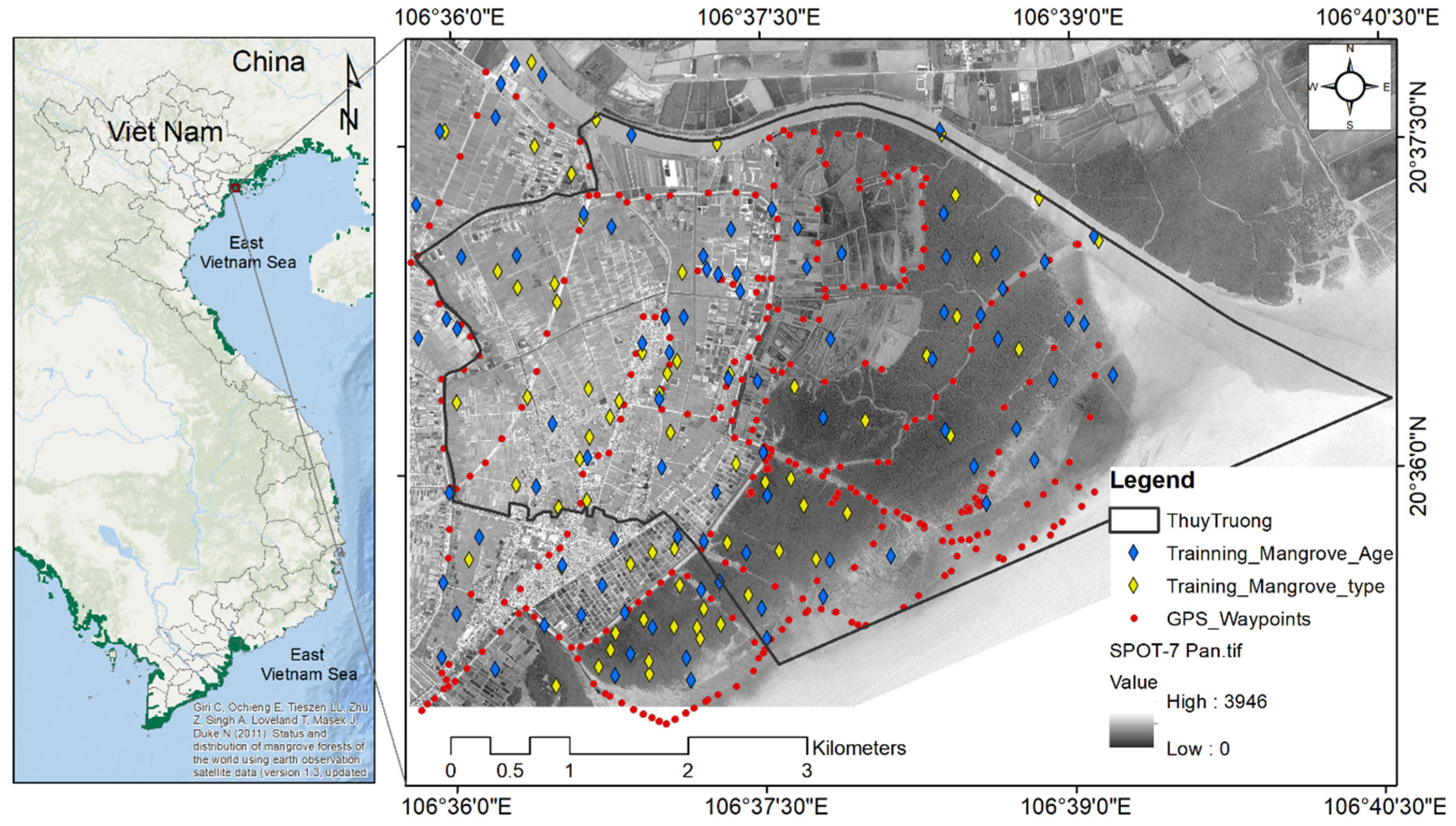
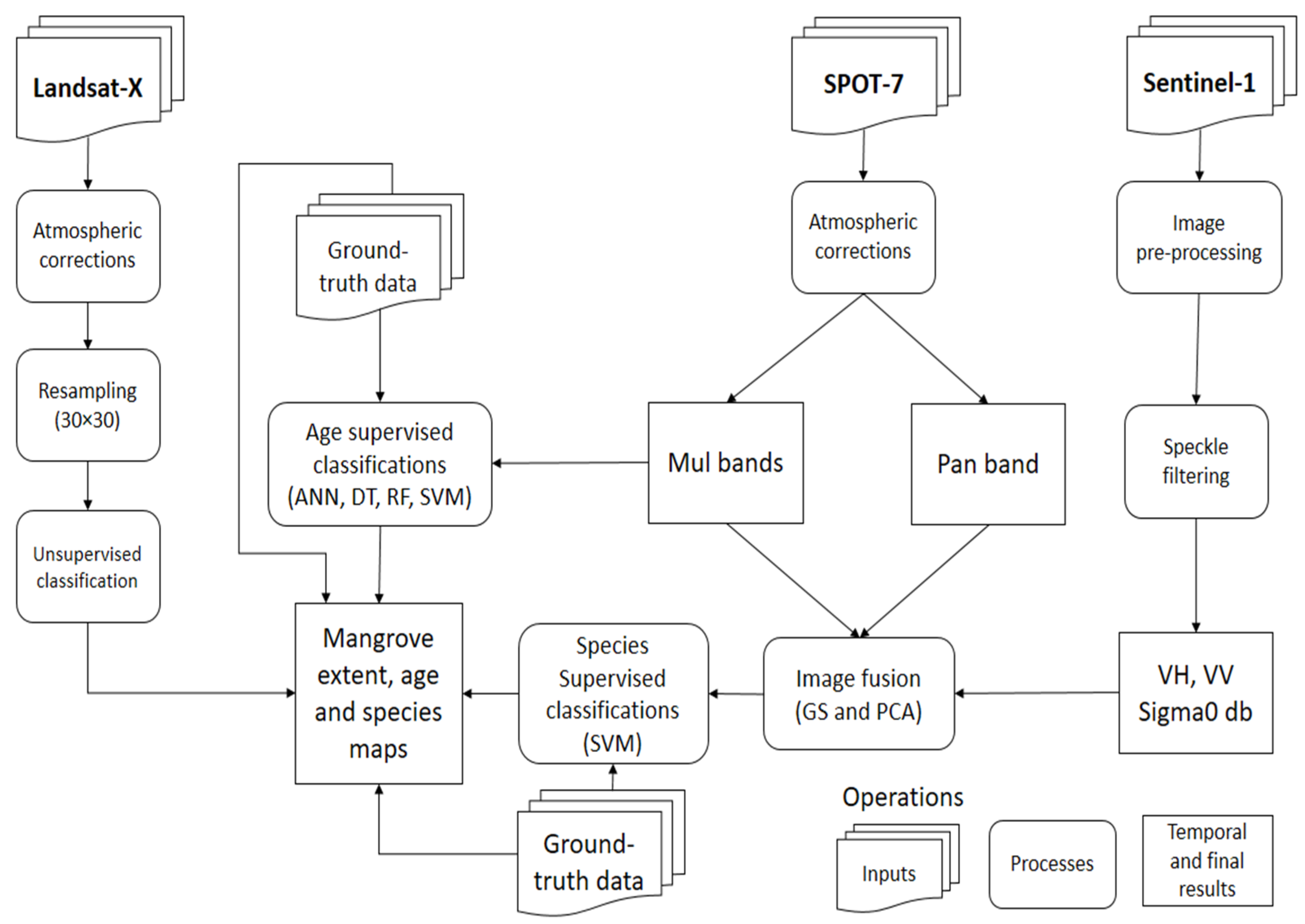
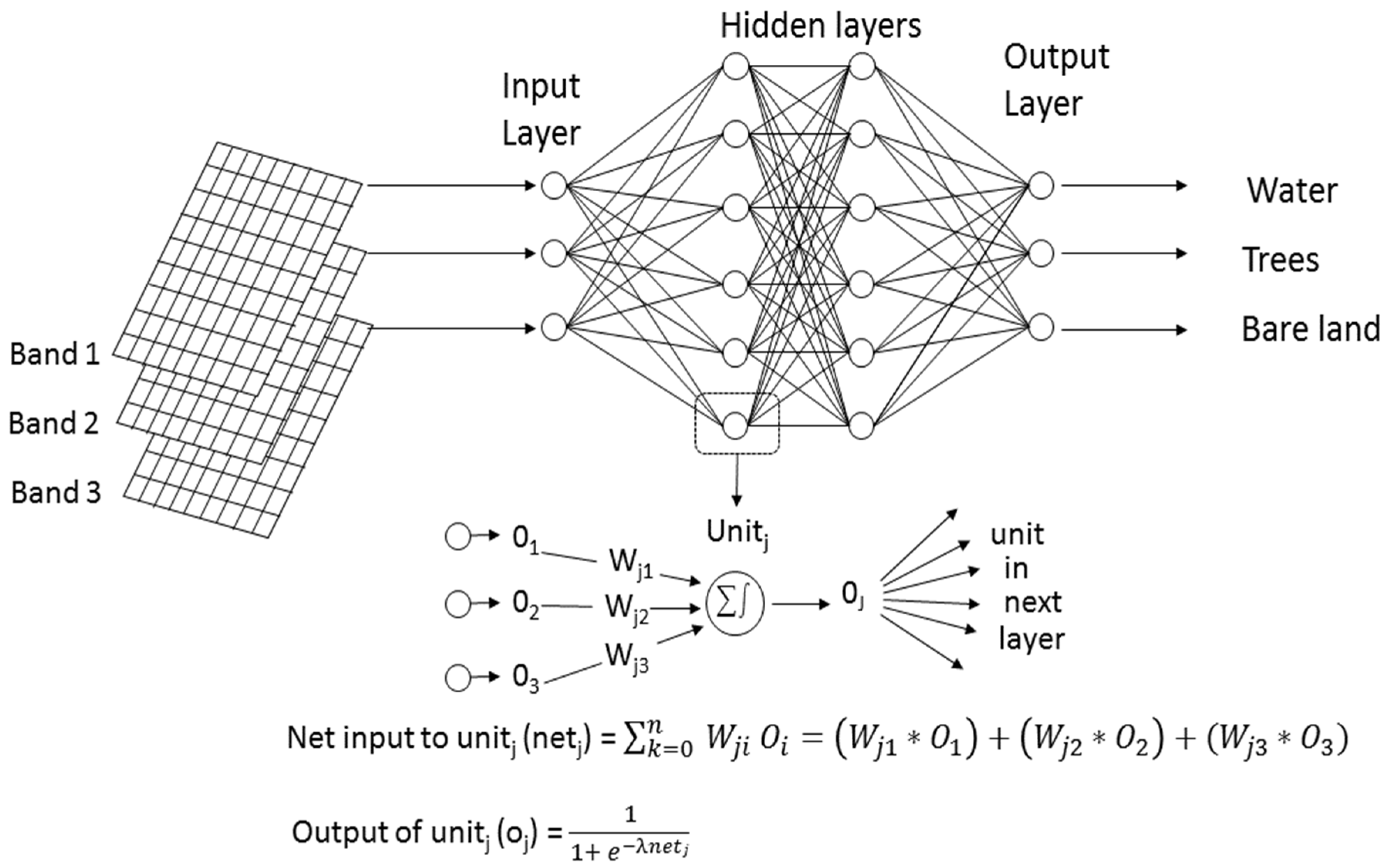

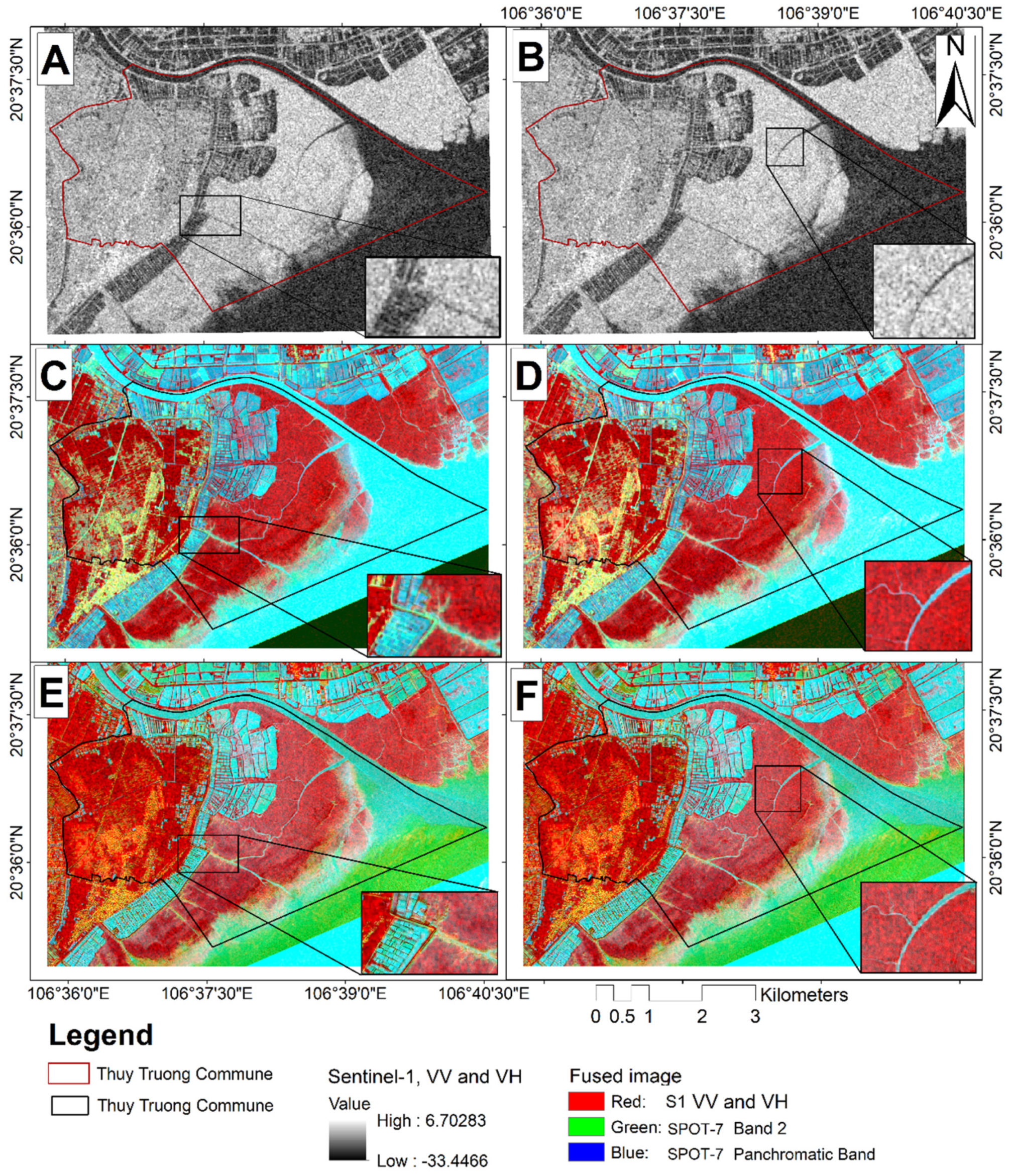
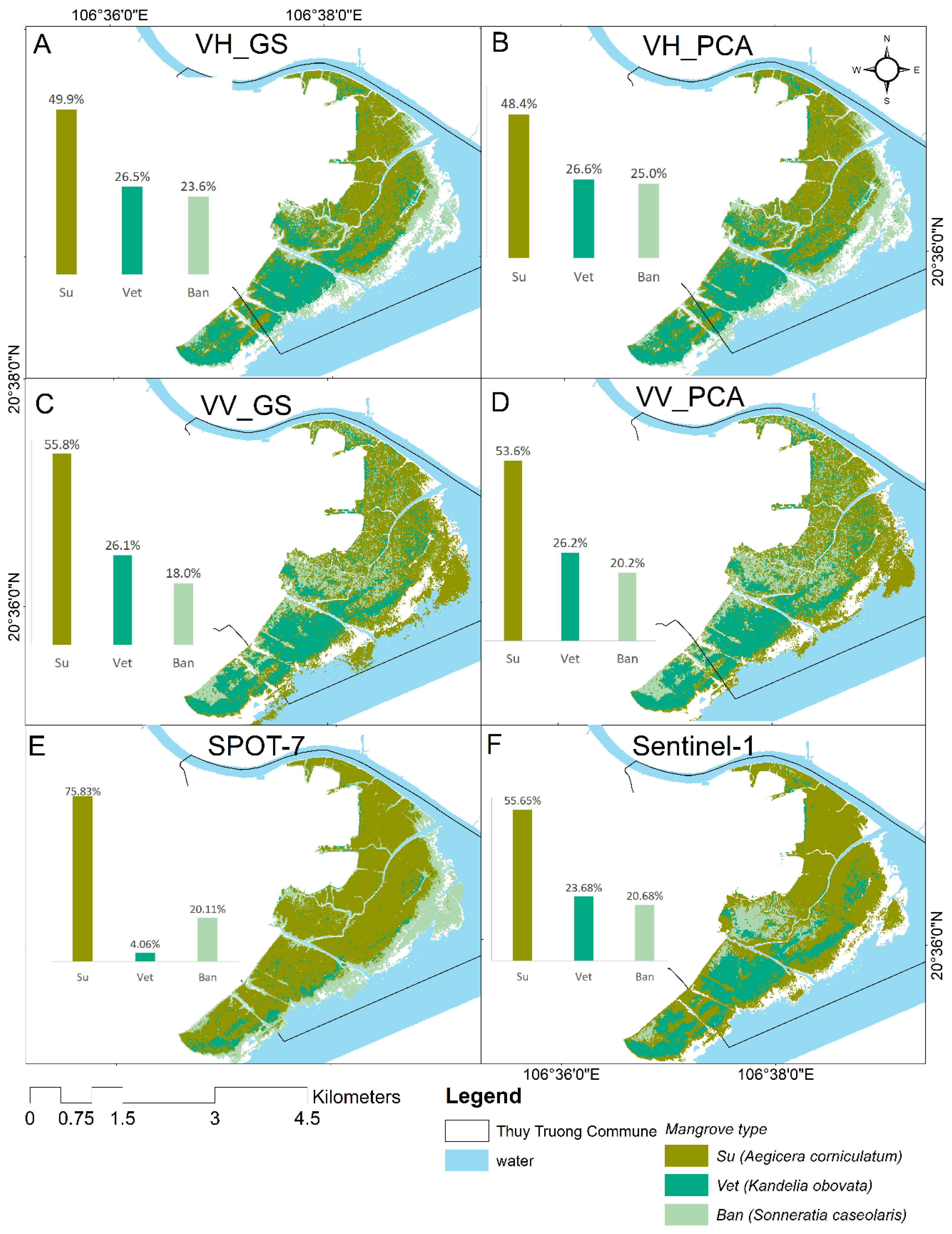
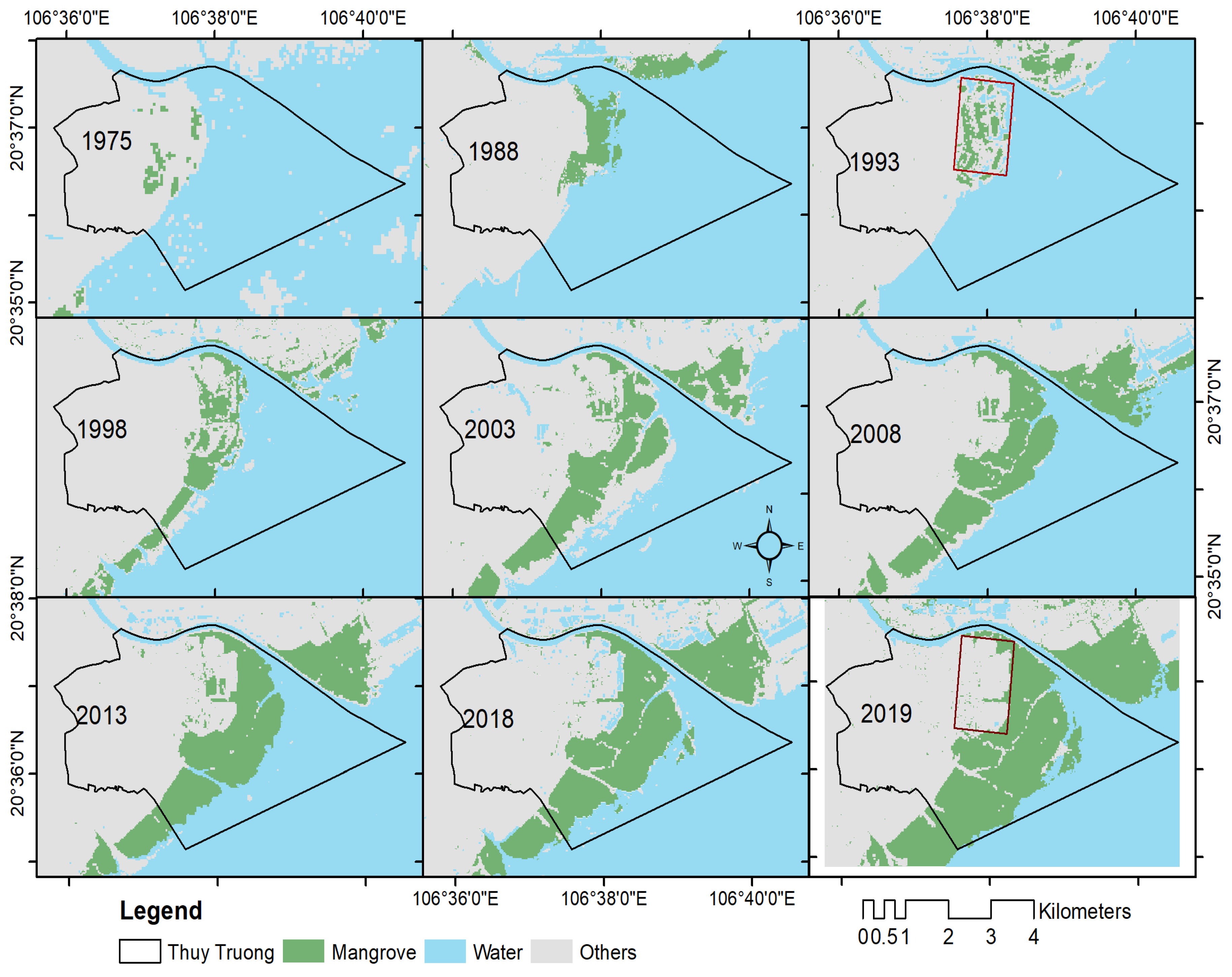
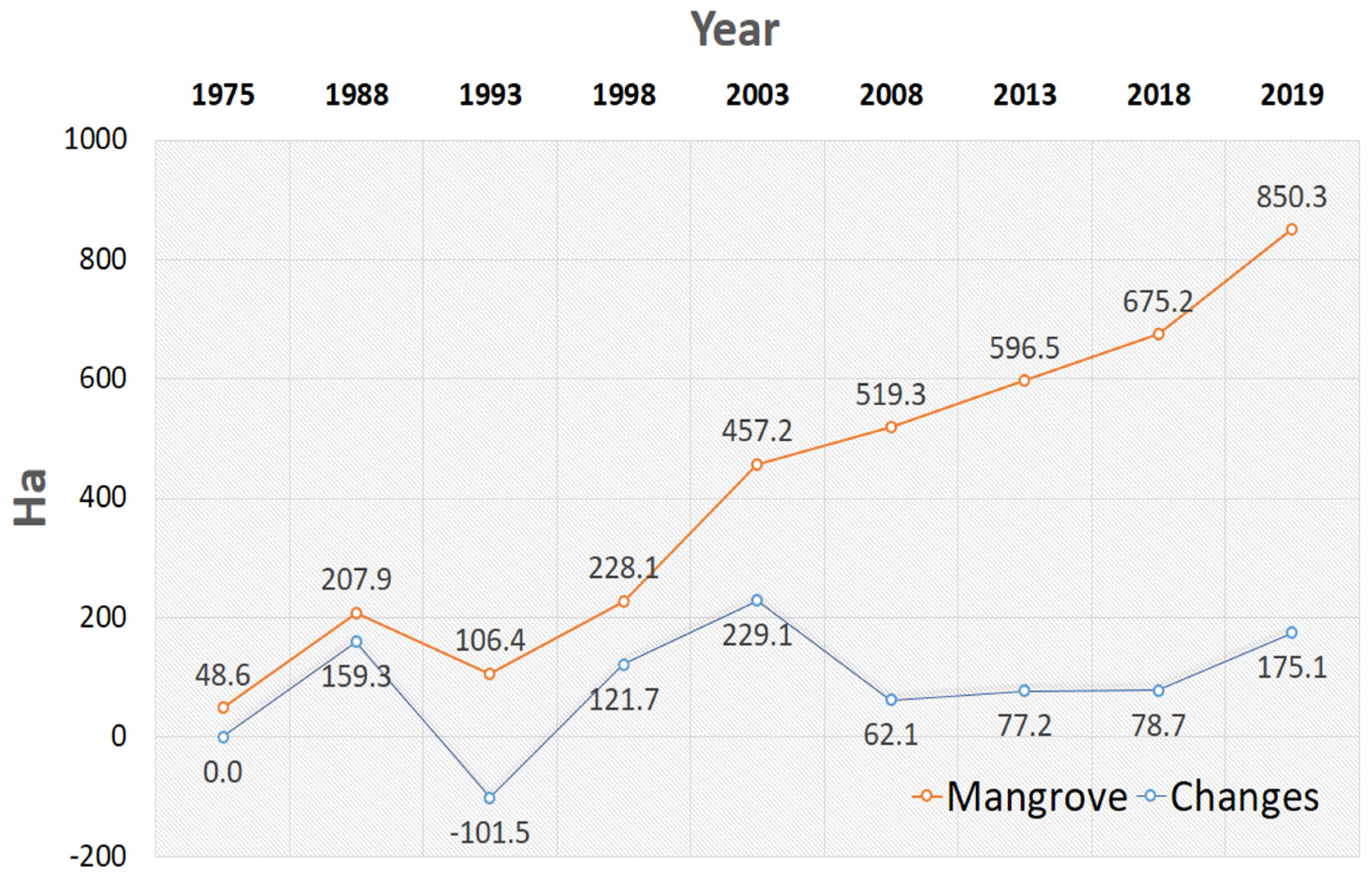


| Training for Mangrove Type | Number of Polygons | Average Area (ha) | Sum Area (ha) | Training for Mangrove Age | Number of Polygons | Average Area (ha) | Sum Area (ha) |
|---|---|---|---|---|---|---|---|
| Agriculture | 8 | 1.6 | 12.4 | Agriculture | 10 | 1.9 | 18.8 |
| Aquaculture | 6 | 1.7 | 10.1 | Aquaculture | 12 | 2.2 | 26.3 |
| Seawater | 4 | 21.5 | 86.1 | Seawater | 5 | 2.5 | 12.4 |
| Bare land | 6 | 0.4 | 2.3 | Bare land | 14 | 0.2 | 3.2 |
| Residence | 6 | 0.9 | 5.1 | Residence | 6 | 1.1 | 6.5 |
| River | 7 | 3.9 | 27.4 | River | 8 | 1.8 | 14.4 |
| Road | 7 | 0.1 | 0.6 | Road | 13 | 0.4 | 5.0 |
| Sonneratia caseolaris (ban) | 9 | 2.1 | 18.9 | >10 year mangrove | 16 | 1.9 | 30.4 |
| Aegiceras corniculatum (Su) | 9 | 1.3 | 11.3 | 5 year mangrove | 10 | 1.2 | 11.7 |
| Kandelia obovata (Vet) | 16 | 0.5 | 7.4 | <3 year mangrove | 11 | 1.2 | 13.1 |
| Sum | 78 (23) | 181.6 | 105 (32) | 141.6 |
| Data | Time of Acquisition | Level | Band and Polarization | Resolution |
|---|---|---|---|---|
| Landsat (X) | 1975/04/20 (2MSS), 1988/11/04 (5TM), 1993/11/02 (5TM), 1998/10/15 (5TM), 2003/10/10 (5TM), 2008/11/11 (5TM), 2013/10/08 (8OLI), 2018/10/06 (8OLI), 2019/05/18 (8OLI) | (2) L1TP, (5) L1TP, (5) L1TP, (5) L1TP, (5) L1TP, (5) L1TP, (8) L1TP, (8) L1TP, (8) L1TP, | (2) 4–6, (5) 1–7, BQA, (5) 1–7, BQA, (5) 1–7, BQA, (5) 1–7, BQA, (5) 1–7, BQA, (8) 1–11, BQA, (8) 1–11, BQA, (8) 1–11, BQA. | (2) 60 m (5) 30 m (5) 30 m (5) 30 m (5) 30 m (5) 30 m (8) 30 m, Pan (B8)15 m (8) 30 m, Pan (B8)15 m (8) 30 m, Pan (B8)15 m |
| SPOT-7 | 2019/05/17 | GPL: Sensor RPL: Basic | Band 0–3 (Mul) Pan | Mul 6 m Pan 1.5 m |
| Sentinel-1 | 2019/05/16 (ascending) | L1 GRD product | VH and VV | 10 m |
| Class | DT | ANN | RF | SVM | ||||
|---|---|---|---|---|---|---|---|---|
| Prod. Acc. (Percent) | User Acc. (Percent) | Prod. Acc. (Percent) | User Acc. (Percent) | Prod. Acc. (Percent) | User Acc. (Percent) | Prod. Acc. (Percent) | User Acc. (Percent) | |
| Ten_Year_Mangrove | 93.86 | 91.14 | 93.31 | 89.77 | 72.45 | 69.20 | 94.67 | 94.62 |
| Five_Year_Mangrove | 72.33 | 76.74 | 59.59 | 73.70 | 62.31 | 36.28 | 84.39 | 81.36 |
| Three_Year_Mangrove | 79.11 | 81.01 | 70.36 | 82.92 | 31.44 | 46.41 | 91.09 | 77.34 |
| River | 97.49 | 99.05 | 93.80 | 99.79 | 97.59 | 48.62 | 98.52 | 98.43 |
| Aquaculture | 88.17 | 86.45 | 90.32 | 78.45 | 18.49 | 60.04 | 83.38 | 94.37 |
| Residence | 92.09 | 91.88 | 89.84 | 70.22 | 34.70 | 18.97 | 94.70 | 93.39 |
| Road | 89.31 | 85.28 | 90.48 | 76.17 | 19.24 | 50.68 | 77.65 | 89.86 |
| Agriculture | 98.71 | 98.9 | 98.14 | 97.82 | 52.03 | 78.09 | 99.00 | 99.59 |
| Seawater | 100 | 99.71 | 100.00 | 99.03 | 99.34 | 99.19 | 100.00 | 100.00 |
| Bare land | 68.31 | 80.2 | 1.83 | 18.48 | 46.40 | 41.62 | 84.14 | 64.69 |
| Overall Accuracy | 87% | Overall Accuracy | 86.72% | Overall Accuracy | 55.76% | Overall Accuracy | 91.96% | |
| Kappa Coefficient | 0.89 | Kappa Coefficient | 0.85 | Kappa Coefficient | 0.50 | Kappa Coefficient | 0.91 | |
| Class | VH_GS | VH_PCA | VV_GS | VV_PCA | SPOT-7 | Sentinel-1 | ||||||
|---|---|---|---|---|---|---|---|---|---|---|---|---|
| Prod. Acc. (Percent) | User Acc. (Percent) | Prod. Acc. (Percent) | User Acc. (Percent) | Prod. Acc. (Percent) | User Acc. (Percent) | Prod. Acc. (Percent) | User Acc. (Percent) | Prod. Acc. (Percent) | User Acc. (Percent) | Prod. Acc. (Percent) | User Acc. (Percent) | |
| Su (A. corniculatum) | 81.46 | 81.92 | 82.03 | 82.71 | 77.14 | 92.95 | 75.63 | 93.33 | 58.43 | 71.62 | 76.44 | 93.23 |
| Vet (K. obovata) | 87.34 | 78.65 | 88.14 | 79.39 | 94.13 | 89.60 | 94.45 | 90.50 | 51.22 | 41.03 | 93.87 | 91.12 |
| Ban (S. caseolaris) | 62.25 | 75.80 | 63.24 | 76.27 | 79.84 | 54.54 | 81.31 | 51.46 | 46.25 | 50.18 | 78.56 | 62.63 |
| Aquaculture | 90.94 | 94.71 | 91.00 | 94.54 | 98.94 | 93.72 | 98.92 | 93.86 | 95.33 | 65.95 | 45.23 | 38.26 |
| Agriculture | 99.21 | 99.50 | 99.25 | 99.52 | 99.88 | 100.00 | 99.88 | 100.00 | 98.60 | 98.48 | 18.95 | 21.65 |
| Residence | 97.52 | 96.89 | 97.23 | 96.53 | 96.59 | 97.29 | 96.58 | 97.31 | 96.07 | 93.33 | 18.45 | 19.34 |
| River | 99.80 | 99.98 | 99.83 | 99.98 | 97.29 | 99.63 | 97.29 | 99.63 | 97.49 | 98.73 | 89.34 | 91.36 |
| Bare land | 78.11 | 61.44 | 76.88 | 61.37 | 92.65 | 64.95 | 92.61 | 68.34 | 86.25 | 86.25 | 23.15 | 31.21 |
| Seawater | 80.31 | 75.63 | 83.21 | 72.14 | 97.62 | 99.97 | 97.62 | 99.97 | 99.96 | 98.97 | 94.12 | 93.67 |
| Overall Accuracy | 89% | Overall Accuracy | 90% | Overall Accuracy | 93% | Overall Accuracy | 93% | Overall Accuracy | 78% | Overall Accuracy | 60% | |
| Kappa Coefficient | 0.88 | Kappa Coefficient | 0.88 | Kappa Coefficient | 0.92 | Kappa Coefficient | 0.92 | Kappa Coefficient | 0.74 | Kappa Coefficient | 0.58 | |
| ISODATA Classified (Pixels) | Ground-Truth (Pixels) | Summary | ||||||||
| Mangrove | Aquaculture | Residence | Agriculture | Bare land | River | Seawater | Total | Prod. Acc. (Percent) | User Acc. (Percent) | |
| Mangrove | 1650 | 25 | 0 | 14 | 2 | 4 | 1 | 1696 | 99.16 | 97.29 |
| Aquaculture | 14 | 905 | 0 | 46 | 7 | 11 | 0 | 983 | 97.00 | 92.07 |
| Residence | 0 | 0 | 289 | 0 | 4 | 0 | 0 | 293 | 88.11 | 98.63 |
| Agriculture | 0 | 2 | 0 | 972 | 11 | 0 | 0 | 985 | 93.82 | 98.68 |
| Bare land | 0 | 0 | 39 | 4 | 589 | 0 | 0 | 632 | 95.93 | 93.20 |
| River | 0 | 0 | 0 | 0 | 0 | 1243 | 9 | 1252 | 98.81 | 99.28 |
| Seawater | 0 | 1 | 0 | 0 | 1 | 0 | 3382 | 3384 | 99.71 | 99.94 |
| Total | 1664 | 933 | 328 | 1036 | 614 | 1258 | 3392 | 9225 | 96.08µ | 97.01µ |
| Overall Accuracy = 97.89% | Kappa Coefficient = 0.97 | |||||||||
| K-Means Classified (Pixels) | Ground-Truth (Pixels) | Summary | ||||||||
| Mangrove | Aquaculture | Residence | Agriculture | Bare land | River | Seawater | Total | Prod. Acc. (Percent) | User Acc. (Percent) | |
| Mangrove | 2754 | 66 | 1 | 22 | 8 | 1 | 0 | 2852 | 89.77 | 96.56 |
| Aquaculture | 261 | 664 | 0 | 1 | 0 | 26 | 0 | 952 | 76.32 | 69.75 |
| Residence | 0 | 0 | 255 | 0 | 9 | 0 | 0 | 264 | 95.86 | 96.59 |
| Agriculture | 1 | 0 | 0 | 744 | 37 | 0 | 0 | 782 | 95.38 | 95.14 |
| Bare land | 0 | 0 | 10 | 13 | 394 | 0 | 0 | 417 | 87.95 | 94.48 |
| River | 52 | 140 | 0 | 0 | 0 | 783 | 0 | 975 | 96.67 | 80.31 |
| Seawater | 0 | 0 | 0 | 0 | 0 | 0 | 2889 | 2889 | 100 | 100 |
| Total | 3068 | 870 | 266 | 780 | 448 | 810 | 2889 | 9131 | 89.77µ | 96.56µ |
| Overall Accuracy = 92.90% | Kappa Coefficient = 0.91 | |||||||||
© 2020 by the authors. Licensee MDPI, Basel, Switzerland. This article is an open access article distributed under the terms and conditions of the Creative Commons Attribution (CC BY) license (http://creativecommons.org/licenses/by/4.0/).
Share and Cite
Quang, N.H.; Quinn, C.H.; Stringer, L.C.; Carrie, R.; Hackney, C.R.; Van Hue, L.T.; Van Tan, D.; Nga, P.T.T. Multi-Decadal Changes in Mangrove Extent, Age and Species in the Red River Estuaries of Viet Nam. Remote Sens. 2020, 12, 2289. https://doi.org/10.3390/rs12142289
Quang NH, Quinn CH, Stringer LC, Carrie R, Hackney CR, Van Hue LT, Van Tan D, Nga PTT. Multi-Decadal Changes in Mangrove Extent, Age and Species in the Red River Estuaries of Viet Nam. Remote Sensing. 2020; 12(14):2289. https://doi.org/10.3390/rs12142289
Chicago/Turabian StyleQuang, Nguyen Hong, Claire H. Quinn, Lindsay C. Stringer, Rachael Carrie, Christopher R. Hackney, Le Thi Van Hue, Dao Van Tan, and Pham Thi Thanh Nga. 2020. "Multi-Decadal Changes in Mangrove Extent, Age and Species in the Red River Estuaries of Viet Nam" Remote Sensing 12, no. 14: 2289. https://doi.org/10.3390/rs12142289
APA StyleQuang, N. H., Quinn, C. H., Stringer, L. C., Carrie, R., Hackney, C. R., Van Hue, L. T., Van Tan, D., & Nga, P. T. T. (2020). Multi-Decadal Changes in Mangrove Extent, Age and Species in the Red River Estuaries of Viet Nam. Remote Sensing, 12(14), 2289. https://doi.org/10.3390/rs12142289






